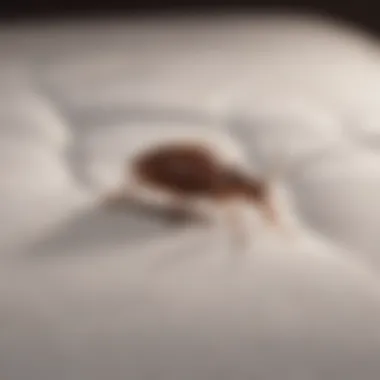Permanent Solutions for Bed Bugs: A Complete Guide


Intro
Bed bugs are not a new problem. Their presence has been recorded throughout history, showing their resiliency to various eradication methods. Understanding this pesky pest is critical for effective countermeasures. In this section, we will delve into the biology, identification, treatment methods, and the significance of detectors for early intervention which are all crucial in managing bed bug infestations.
Animal Species Profile
Prologue to Bed Bugs
Bed bugs belong to the Cimicidae family, and they are hematophagous insects. These small, parasitic pests typically feed on the blood of humans and other warm-blooded mammals. Their scientific name is Cimex lectularius, and they thrive in human habitats, making them a common household nuisance.
Physical Characteristics and Appearance
Adult bed bugs are approximately 4 to 5 mm long, with a flat, oval shape. Their coloration ranges from reddish-brown to a brighter hue after feeding. Younger stages, known as nymphs, are smaller and lighter in color, making them challenging to spot. If squished, they can yield a noticeable stain, which can be a key identification clue.
Natural Habitat and Distribution
These pests tend to reside in warm environments, often in the seams of mattresses, bed frames, and furniture. They spread easily through clothing, luggage, and shared living spaces. Bed bugs do not fly, but they can crawl quickly and hide in small crevices.
Behavior and Social Interactions
Bed bugs display a relatively simple social structure. They are solitary feeders and come together only during mating. Their behavior relies on proximity to hosts for feeding and seeking shelter. After engaging in a simple reproductive process called traumatic insemination, bed bugs usually return to isolated hiding spots.
Key Identification Techniques
Being timely and accurate in identification is key. Homeowners can look for specific signs, those are:
- Bite marks: Commonly appear in a linear series.
- Fecal spotting: Dark spots seen on sheets.
- Shed skins: Remains of nymphs as they grow.
- Sightings: Observations at night, indicating feeding times.
Treatment Options
Addressing a bed bug infestation requires a multi-faceted approach; here are permanent solutions:
- Professional Extermination: Hiring licensed pest control services specializing in bed bugs ensures thorough eradication. Professionals use a combination of methods, including chemical treatments and heat treatments, to eliminate them thoroughly.
- Heat Treatments: Bed bugs cannot survive at temperatures above 120°F (49°C). Disinfestation through heating the affected area can be a highly effective method.
- Physical Removal: Washing bedding and vacuuming can regulate and control the population. However, these methods should be supplemented with more comprehensive approaches for lasting results.
- Encasements: Bed bug-proof mattress and box spring encasements can help prevent infestations with future hosts.
- Ongoing Management: Reassessment and continual treatment may be required. Staying educated about bed bug behavior and symptoms can prevent reinfestation. Consistent monitoring gives homeowners an edge in permanent success against these pests.
Understanding bed bugs and maintaining preventative measures are crucial for ensuring a pest-free environment.
Staying informed and taking proactive steps is vital. Employ other control methods such as regular inspections and possible consultation from experts before the problem escalates. Readers can rely on detailed insights as they navigate the often challenging waters of eliminating bed bugs effectively. Proper knowledge and systematic approaches are essential for enabling long-term damages caused by bed bugs.
Understanding Bed Bugs
The topic of understanding bed bugs is paramount in effectively managing and eradicating these pests. Knowledge about bed bugs' biology, their behavior, and how to recognize signs of infestation are essential for any homeowner or pest control professional aiming to implement permanent solutions. Gaining insight into these areas not only aids in the identification of existing infestations but also empowers individuals to prevent future occurrences.
Biology and Behavior
Bed bugs, scientifically known as Cimex lectularius, are small, resilient insects that primarily feed on human blood. These pests possess a flattened, oval body shape and can vary in color from brown to red depending on their feeding status. Adult bed bugs typically measure about 4 to 5 mm in length.
These insects are predominantly nocturnal, making their habits particularly challenging for those without experience. They spend their days hiding in crevices, focusing on locations such as bed frames, mattresses, wall cracks, and even wallpaper. Understanding their tendences can significantly improve detection and eradication efforts.
Furthermore, bed bugs are notable for their ability to reproduce quickly. A single female can lay hundreds of eggs during her lifespan. These eggs hatch into nymphs, which require multiple blood meals to attain maturity. Such rapid reproduction can lead to overwhelming infestations if not addressed immediately. Armed with knowledge about these aspects, homeowners can identify infestations sooner and respond more effectively.
Signs of Infestation
Recognizing the signs of bed bug infestations is crucial for prompt action. Common indicators include:
- Bite Marks: Bed bug bites often appear in small clusters on exposed skin and can cause itchy welts.
- Blood Stains: Tiny rust-colored stains may appear on sheets and mattresses, caused by bed bugs being crushed after feeding.
- Fecal Spots: Dark spots of feces, roughly the size of a dot made with a marker, can often be found in or around commonly infested areas.
- Shed Skins: As bed bugs develop through various life stages, they grip the surface tightly as they shed their exoskeleton.
Identifying any of these warning signs can mean that immediate action is necessary.
Understanding bed bugs is crucial. Knowledge promotes early detection and addresses potential infestations more effectively.
Being vigilant allows for prompt measures to counteract these significant nuisances. Individuals aiming to tackle possible infestations require solid knowledge on biology and signs related with bed bugs to ensure long-term solutions.
Identifying Bed Bugs
Identifying bed bugs accurately is paramount in dealing with a pest infestation effectively. Failure to recognize these insects can lead to unchecked populations and increased discomfort for those affected. Having knowledge on how to identify bed bugs is not only valuable but vital for prompt treatment and management.
It allows for immediate action, which can mean a significant difference in the scope of pest control. Criteria such as their physical characteristics and preferred hiding spots are key for homeowners and pest control professionals alike. Awareness cultivates a proactive approach, reducing emotional stress and improving environmental hygiene.


Physical Characteristics
Bed bugs exhibit distinct physical traits that make them relatively easy to identify once spotted. Adult bed bugs are usually brown, with a flattened oval shape. They roughly measure around 4 to 5 millimeters in length when fully grown. Their bodies change color to a deeper red after a blood meal, making it simpler to track their presence. It's also helpful to look for their eggs, which are tiny, about 1 millimeter long, and appear white or translucent.
Some key characteristics to observe include:
- Body Shape: Adults have a flat, round shape pre-feeding.
- Color Changes: A reddish hue indicates they have recently fed.
- Size Variation: Nymphs are smaller, thus more challenging to see, measuring between 1 and 4 millimeters depending on the stage of development.
- Antennas and Eyes: Their antennas have a zig-zag pattern and compound eyes, which can be another distinctive aspect.
Knowing how to identify bed bugs effectively allows individuals to confirm suspicions rather than ignoring signs of infestation.
Common Hiding Spots
Bed bugs are adept at concealing themselves in many common household surroundings. Recognizing where these insects typically take refuge is essential in the identification process.
Typically, bed bugs thrive in locations that offer proximity to sleeping areas. They tend to hide in:
- Mattresses and Box Springs: Often found in seams, crevices, or folds.
- Bed Frames and Headboards: Cracks and joints provide perfect hiding spots.
- Furniture: Couches and chairs often have similar crevices.
- Baseboards and Wallpapers: They can sneak behind fixtures in search of safety.
- Luggage and Clothes: Travel items are common subjects of bed bug infestation.
Infectious infamy: “Bed bugs are experts at evasion. They can fit into spaces smaller than their body thickness due to their flexible body.”
For effective monitoring, potential hideouts should be regularly inspected. With vigilant checks and proper identification methods, lasting solutions to manage these unwanted companions become achievable. By understanding where to look, the chances of early detection and intervention can substantially improve.
Health Implications
Understanding the health implications of bed bug infestations is vital for addressing the issue effectively. While primarily seen as a nuisance, the presence of bed bugs can lead to serious health concerns. Recognizing these impacts allows both individuals and pest control professionals to develop effective strategies for eradication and prevention. It is crucial to delve deeper into this topic to understand the associated allergic reactions and psychological effects on victims.
Allergic Reactions
Bed bugs can cause a range of allergic reactions that vary in severity from person to person. Some individuals may experience minor symptoms such as itching and redness, while others might develop severe reactions. Allergic responses primarily arise from bed bug bites, which some people are sensitive to. When a bed bug feeds, it injects saliva into the skin to prevent blood clotting, provoking an immune response. This can lead to:
- Localized redness and swelling.
- Intense itching, leading to additional skin irritation.
- Secondary infections from scratching, where bacteria can enter through damaged skin.
- In extreme scenarios, individuals might experience anaphylaxis, a severe, life-threatening allergic reaction.
To mitigate the risk of allergic reactions, people must take prompt action if they suspect an infestation. Regular inspections can help identify early signs and prompt treatment before reactions escalate. Moreover, awareness of one's sensitivities can guide effective response strategies.
Psychological Impact
The psychological burden caused by bed bugs extends far beyond mere annoyance. The stress and anxiety associated with an infestation can affect daily lives and overall mental health. Studies indicate that individuals dealing with bed bugs often experience:
- Sleep disturbances. The fear of being bitten can lead to insomnia or restless nights, ultimately diminishing focus and productivity during the day.
- Increased anxiety and worry. The persistent concern about infestations can lead to compulsive behaviors to ensure that an environment is bed bug-free.
- Social stigmatization. Many perceive bed bugs as a reflection of poor hygiene, leading to feelings of shame and isolation.
- Post-Traumatic Stress Disorder. In extreme cases, individuals can develop lasting anxiety or PTSD-like symptoms, making it difficult to regain a sense of normalcy.
It is essential for those suffering from bed bug infestations to seek comprehensive treatment that includes psychological support as well. Professional pest control services can eliminate the physical presence of bed bugs, but addressing psychological effects can enhance individuals' ability to cope and lead to a more complete recovery.
A collaborative approach that incorporates both health and psychological considerations can effectively mitigate the overall impact of bed bugs on human welfare.
Ultimately, recognizing and understanding these health implications paves the way for more effective eradication strategies and preventative measures. Both individual and societal actions are needed for long-term solutions against this pervasive pest problem.
Prevention Strategies
Preventive strategies hold crucial importance when dealing with bed bugs. These tiny pests proliferate in households, and a successful approach calls for vigilant measures. A proactive mindset can drastically reduce the chances of an infestation. Not only do these strategies aim to prevent the entry of bed bugs, but they also educate individuals about the signs of potential problems.
Implementing these strategies offers various benefits. First, it can save time and money. Addressing infestations early is often cheaper than remediate a significant problem. Second, understanding prevention helps foster healthier living conditions, reducing stress associated with unexpected pests. Noteworthy considerations include ongoing awareness and the obligation to maintain new behaviors around cleanliness and vigilance when traveling or welcoming new items into the home.
Regular Inspections
Carrying out regular inspections is one of the fundamental prevention strategies against bed bugs. Understanding their hiding habits is advantageous. Most people think that spotting a bed bug means the infestation is severe, but that isn't always the case. Early detection typically hosts a greater chance of eradication.
During each rountine check, focus your attention on areas such as:
- Mattress seams: These dense areas are often where bed bugs lay eggs.
- Furnishing cracks: Wing chairs, sofas, and other obstructions create perfect resting spots for these insects.
- Carpets or rugs: Once inside, bed bugs can travel quickly and without being seen.
- Luggage or purses: Any recently traveled item needs inspection.
Once an inspection reveals potential signs, act swiftly. Tools such as a flashlight and a magnifying glass can greatly assist in the search for these pests.
Safe Practices for Travelers
Travel often increases the risk of bringing bed bugs home. Travelers must adopt safe practices to reduce the likelihood of infestations. Before you embark on everyone's favorite part of the trip, think of implementing the following precautions.
- Inspect Hotel Rooms: As soon as you enter, examine the mattress seams and place your luggage on a luggage rack or the desk, ensuring it stays off surfaces like beds or carpets.
- Limit Packing Fabrics: Use hard-shell luggage, and linen can harbor tiny creatures. The fewer fabric items, the lower the chances of a transfer.
- Quick Wash After Return: As soon as you get home, wash clothing, regardless of whether they were worn. This helps eliminate bed bugs because they'll be washed away in the warm cycle.
- Store Luggage Smartly: Post-trip, don’t leave bags unattended on carpets. During returning, put them in well-lit areas to check for any signs of sanitation problems.
Quick Tip: Keeping all these in mind ensures that you convert your travel-safe practices into a buffer against unwanted cleanup upon return home.


Chemical Treatments
The significance of chemical treatments in the context of bed bug elimination cannot be overstated. These strategies serve as essential tools in the combat against persistent bed bug populations. Chemical treatments possess distinct advantages, such as rapid action and broader reach than many non-chemical measures. However, alongside the benefits, it's crucial to recognize their limitations and the importance of responsible use in a comprehensive pest management plan. The balance between efficacy and safety remains a paramount concern, particularly for homeowners and pet owners, given the potential for chemical exposure.
Insecticides Overview
Insecticides are often categorized into various types based on their active ingredients and modes of action. The effectiveness of each insecticide can depend heavily on the material's composition and the behavior of the bed bugs. Here are a few common categories:
- Pyrethroids: These are synthetic chemicals modeled after natural insecticides found in chrysanthemum flowers. They are widely used due to their rapid action and relatively low toxicity to humans and pets, but some bed bug populations may have developed resistance to them.
- Neonicotinoids: These insecticides affect the nervous system of pests. They are effective against bed bugs, yet they require cautious application due to potential environmental impacts.
- Biochemical insecticides: Such as enzymes and botanically derived agents are increasingly recognized for their potency against bed bugs without the same risk profile of traditional chemicals. Examples are diatomaceous earth and essential oil-based treatments.
A thorough understanding of an insecticide's mechanism and potential resistance is critical to ensure effective treatment.
It's essential to understand, however, that simply applying a chemical treatment may not be sufficient on its own. A deeper approach is needed to combat infestations effectively.
Application Methods
The method of applying insecticides greatly influences their efficacy and the safety of the involved parties. Various application techniques are employed to ensure maximum penetration into the hiding spots constitute the crucial steps:
- Spraying: This method involves using liquid insecticides sprayed directly onto affected areas. Users need to ensure even coverage while avoiding oversaturation, which might be harmful.
- Fogging: This approach disperses a mist of chemical into the air in heavily infested zones. It allows reach into nooks and crannies commonly occupied by bed bugs.
- Duster Application: Often preferred for dry formulations, a duster proficiently delivers insecticide powders into crevices and small spaces, ideal for hard-to-reach areas.
- Baiting Systems: Though less common for bed bugs, any bait strategies available can harness the attraction to specific chemical lures that draw bugs for reduction.
Maintenance and frequency of applications depend on previous infestation severity. Additionally, always read and conform to product label instructions for warranty and safety guidelines. Understanding these chemical treatment options paves the way for more strategic pest management planning.
Non-Chemical Treatments
In the pursuit of effective and enduring solutions for bed bug infestations, non-chemical treatments hold significant relevance. These methods offer alternatives that minimize the dangers associated with chemical substances while providing both immediate and lasting effects on eradicating bed bugs. Using non-chemical treatments can also help mitigate health concerns related to chemical exposure, making them ideal for households with children or pets.
Heat Treatment
Heat treatment is a preferred non-chemical method to eliminate bed bugs, gaining increasing attention due to its effectiveness. This technique involves elevating spaces, such as bedrooms or entire homes, to temperatures lethal to bed bugs, typically above 120°F (48°C).
Advantages of Heat Treatment:
- Effectiveness: A well-executed heat treatment can eradicate bed bugs in all life stages—eggs, nymphs, and adults—ensuring that future infestations are prevented.
- Safety: Unlike chemical treatments, heating is inherently less hazardous. When implementing this treatment, it is crucial to ensure that all areas are reachable and properly treated, as bed bugs often hide in crack and crevices.
- Residual Effects: Heat doesn’t leave behind residue and does not require post-treatment washing of non-durable items.
However, implementation does require equipment capable of distributing heat uniformly. Professional services generally use specialized heating systems, as home methods might lack precision.
Steam Cleaning
Steam cleaning represents another effective non-chemical measure, known for its practicality in combating bed bugs. This method leverages high-temperature steam to kill bugs on contact while sanitizing surfaces where infestations are typically found, such as upholstery and mattress seams.
Benefits of Steam Cleaning:
- Immediate Impact: When applied correctly, steam can kill bed bugs on contact, making steam cleaning a quick solution for visible infestations.
- Surface Sanitizing: It not only addresses the bugs but also cleans the area, enhancing hygiene and helping to remove associated allergens and debris.
- Accessibility: Steam cleaning equipment, such as portable steamers, is increasingly widely available to consumers.
Although non-chemical treatments like heat and steam cleaning are effective means to combat bed bugs, having a comprehensive strategy that includes them with traditional methods often produces the best outcomes. Enforcing preventive practices and constantly monitoring for signs of bed bugs will further support these efforts in achieving a permanent solution.
Integrated Pest Management
Integrated Pest Management (IPM) is a fundamental component in addressing bed bug infestations. It represents a systematic approach that combines several strategies targeting the pest populations while minimizing harm to human health and the environment. The importance of implementing an effective IPM system in your pest control efforts cannot be overstated. This framework emphasizes prevention, monitoring, and control in a balanced manner. Therefore, understanding and executing IPM principles is crucial for anyone dealing with home or industrial pest issues.
The benefits of IPM are substantial. First, it offers comprehensive strategies that not only deal with present infestations but also reduce the likelihood of future outbreaks. This holistic method leads to reduced chemical use, ultimately protecting non-target species, which can include pets and beneficial insects. Additionally, IPM encourages continual evaluation of pest statuses, resulting in informed decisions that shape each step of the control strategy.
Key elements of Integrated Pest Management include:
- Identification: Qualification of the pest type involved is the first step in IPM.
- Monitoring: Regular searches for bed bugs to determine the severity of the infestation can guide treatment decisions.
- Prevention: Implementing exclusion practices to mitigate future infestations can significantly reduce the instances of bed bugs returning.
- Control: Utilizing various control measures, including the integration of chemical and non-chemical treatments, tailored to the unique requirements of a given environment.
The IPM approach lays the groundwork for a sustainable method of pest management that promotes responsible practices.
Concept and Execution
The practical application of Integrated Pest Management involves a thorough process, beginning with the identification of the infestation. Bed bugs exhibit distinct behaviors which help to ascertain their presence. Regular inspections of harboring sites, particularly in beds and furniture, help in early detection. Once confirmed, it is important to gather more information about the nature of the infestation: Is it isolated or widespread? This understanding influences the pest treatment options available.
With accurate data in hand, execution can proceed through a case-by-case analysis. Control strategies often include collaboration among various pest control efforts such as steam treatment, heat treatments, and targeted application of insecticides. Each interaction requires skilled assessment of existing conditions such as temperature and humidity that could affect efficacy. Continuous evaluation during each phase ensures the response is adequately addressing the needs.
Ultimately, competency in managing the operation effectively leads to overcoming bed bug issues efficiently and responsibly.
Long-Term Strategies


Long-term strategies are vital concerns under the Integrated Pest Management regime. A one-off treatment seldom suffices. Bed bugs can persistently exploit alternate locations, making durable solutions critical. To uphold a pest-free environment, the application of long-term strategies is essential:
- Consistent Monitoring: Regular vigilance can help to intercept any potential reinfestation well in advance.
- Education: Knowledge about the biology and habits of bed bugs equips individuals with the tools needed for preventative measures.
- Coordination in Prevention: Harmonizing efforts with neighbors, hotels, or other establishments can fundamentally reduce populations and break cycles that allow bed bugs to thrive.
- Reassess Chemical Usage: It's crucial to monitor resistance to certain pest treatments and alter accordingly to foster a greater pest management safety net.
Sustained engagement reinforces the objectives of Integrated Pest Management. Ensuring that each layer of treatment and prevention strategy bespeaks adaptability and surveillance safeguards long-term success against bed bugs.
Professional Pest Control Services
The role of professional pest control services is crucial in tackling bed bug infestations effectively. Experienced pest control professionals bring specialized knowledge and techniques to these challenges that regular household solutions often can't meet. They understand the biology and behavior of bed bugs deeply. This enables them to tailor their approach for specific infestations. Furthermore, pest control services can provide targeted treatments that ensure bed bugs are eradicated more quickly and with fewer risks.
One significant benefit of engaging professional services is access to advanced tools and chemicals, which most homeowners may not have. These include thermal chambers, eco-friendly insecticides, and specialized monitoring units that accurately gauge reinfestion risk. Expert technicians will apply these treatments in a methodical manner, ensuring deeper penetration into substrates where bed bugs may hide.
When selecting a pest control service, it is wise to look for certifications, customer reviews, and the history of success rate within similar situations. Professionals can also provide ongoing support for monitoring and evaluating effectiveness post-treatment plans. Such benefits make them an invaluable asset in the quest to completely eliminate bed bugs.
Choosing the Right Service
Selecting an appropriate pest control service can greatly influence the outcome of a bed bug eradication attempt. Start by identifying several services in your area. Look for companies that specialize specifically in bed bug management, as their focus lends itself to better results.
Key Considerations
When finalizing your options, consider the following:
- Experience: The duration the company has been active in pest control, particularly bed bugs.
- Licensing and Certification: Ensure that the company holds valid licenses, indicating compliance with local regulations.
- Methods Used: Different companies employ varied techniques, ranging from chemicals to heat treatments. Research the ones they primarily use.
- Customer Service: Availability for inquiries and responsiveness to your specific concerns are vital. Good service should not be limited to the treatment alone but extend to advising on preventive measures.
(/vps#pointers)
Requesting a consultation will enable you to ask questions regarding their process. This could show their transparency. It also permits viewing reviews and comparing quotes. Aim for companies that provide clear post-service support.
Evaluating Effectiveness
Once a professional has been hired and treatments have taken place, it is critical to evaluate the effectiveness of the service received. This process is vital to ascertain that bed bugs have been eliminated and that the home is no longer at risk of severe infestation.
Steps for Evaluation
- Continual Monitoring: Utilize bed bug monitoring tools such as traps or visual inspections to track any signs of bed bugs. Regular checks in high-risk areas can help catch an issue before it escalates again.
- Follow-up Visits: A reputable service will offer follow-up visits after the initial treatments. Discuss the outcomes to determine if additional treatments are necessary.
- Passive Monitors: These low-profile detectors can help gauge any new activity without drawing attention. It is ideal for locations like bedrooms or common spaces.
Monitoring after treatment keeps your environment safe from stray pests and helps identify issues early before they become persistent.
Establish a time frame after which you will thoroughly reevaluate the situation. Speak to professionals again if any issues arise. Their ongoing knowledge can provide invaluable insights into why bugs would remain stubborn.
By rigorously pursuing evaluations, you gained understanding of service efficacy and the importance of timely follow-up in your ongoing efforts against bed bugs.
Post-Treatment Management
Post-treatment management is a crucial phase in the battle against bed bugs. Implementing effective strategies after the initial treatment can significantly reduce the chances of re-infestation, ensuring your living space remains comfortable and safe. The importance of post-treatment management stems from the understanding that bed bug elimination is not merely about applying treatments; it also involves consistent monitoring and proactive prevention.
Monitoring the Area
To keep bed bugs at bay, continuous monitoring of the treated areas is essential. This involves regular inspections of already treated locations such as bedrooms, living rooms, and luggage stowing areas. Look for signs that suggest bed bugs might be returning, such as shed skins, fecal spots, or blood stains. Traps can also be employed as an effective tool for capturing any lingering pests. By placing sticky traps in strategic locations, residents can conduct make-shift surveillance without much effort.
Key Aspects of Monitoring:
- Frequency: Regular observations are essential. Aim for inspections every one to two weeks for the first few months following treatment.
- Tool Usage: Utilizing magnifying glasses and LED light sources can assist in identifying bed bugs in concealing spots.
- Documentation: Keeping track of any signs of bed bugs and the outcomes of inspections can help in identifying patterns or cycles, thus informing future preventions.
End
Addressing the persistent challenge of bed bug infestations cannot be overstated. This article highlights the comprehensive strategies that contribute to the effective management and elimination of bed bugs in various settings. The successful execution of these strategies ensures that both individuals and communities are equipped with the necessary tools to combat these resilient pests.
Summary of Effective Strategies
Employing a multi-faceted approach is crucial in the fight against bed bugs. A combination of thorough inspections, appropriate chemical and non-chemical treatments, and continued vigilance creates a fortified defense against future infestations. Strategies include:
- Regular Inspections: Checking for signs of bed bugs can aid in early detection.
- Use of Chemical Treatments: Application of insecticides must be performed according to manufacturer's instructions to ensure effectiveness.
- Alternative Treatments: Methods such as heat treatment can serve as effective non-chemical solutions.
- Integrative Pest Management: A holistic approach that combines multiple tactics can increase the chances of a successful eradication.
Feeling empowered by knowledge equips individuals, especially homeowners and pest control professionals, to take decisive action against bed bugs, leading to peaceful, bug-free environments.
Future Considerations
Future considerations in bed bug management and eradication should center around evolving strategies that adapt to the insect’s resilience and behavior. Possible developments include:
- Emerging Technologies: Innovative solutions, such as the use of pheromone traps and drones for inspection, may enhance detection capabilities.
- Public Awareness Campaigns: Increased education on prevention and identification can mitigate the incidence.
- Research and Development: Continuous study of bed bug biology can lead to the development of new treatments or practices that address current challenges effectively.
The ongoing evolution of techniques in pest management offers promising avenues for more effective solutions in the future, ensuring that individuals are better defended against bed bug infestations.
Effective management now leads to a significant reduction in bed bug troubles in the future.







